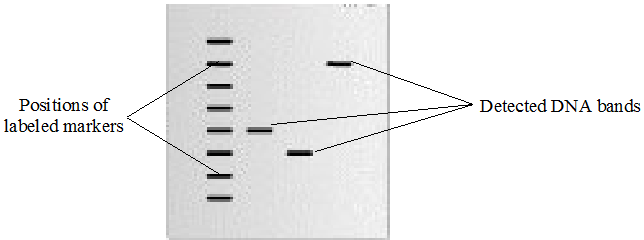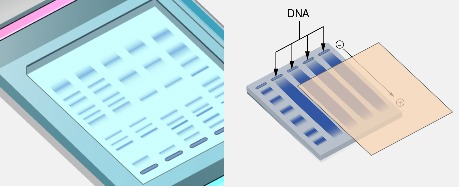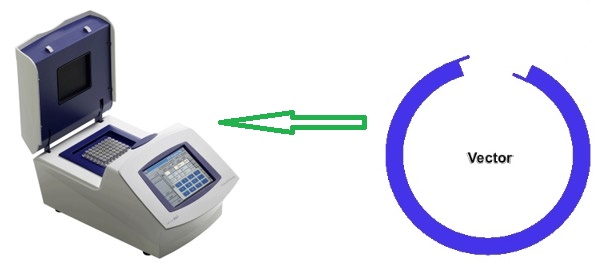Southern blotting technique is a molecular biology technique in which deoxyribonucleic acid (DNA) is transferred from a gel matrix onto a nitrocellulose matrix or paper. Southern blotting technique was first described by Sir Edward M. Southern in 1975 as a molecular biology technique for identifying specific nucleotide sequence of a piece of DNA.
It is generally used to detect specific sequences of DNA molecules from a sample. Southern blotting technique is used to identify structural differences between genomes as well as to study related DNA sequences of a particular genome. It is applied in a variety of molecular biology technique, especially for the detection of gene fragments from a whole DNA band on a gel matrix.
With southern blotting, the actual genetic information that a piece of DNA molecule is carrying can be decoded. Southern blotting incorporates a hybridization process in which specific sequences of nucleotides among many fragments of DNA already separated by gel electrophoresis can be identified specifically.
With the help of radioactive or radiolabelled oligonucleotides (i.e. gene probes), specific sequences of DNA can be marked or labeled and identified. Southern blotting technique can be used for paternity testing, in forensic sciences to solve crimes and for personal identification procedures.
STEPS FOR SOUTHERN BLOTTING
Southern blotting is a molecular biology technique that is used to identify structural differences between genomes as well as to study related DNA sequences of a particular genome. The steps of performing southern blotting technique are highlighted in this unit as follows:
- Digest the DNA to be analyzed with specific restriction endonuclease.
- Perform agarose gel electrophoresis (as earlier described) on the digested DNA fragments.
- Neutralize the separated DNA fragments by soaking the gel slab in an alkaline solution such as sodium hydroxide (NaOH). DNA is denatured at this stage.
- Transfer the gel slab (carrying the fractionated DNA fragments) onto a nitrocellulose paper or nylon membrane by blotting. Practically, the single-stranded DNA is transferred by capillary action to a stack of nitrocellulose paper or membrane.
- Place a weight on the stack of nitrocellulose membrane in order to hold the blot in place. The nitrocellulose membrane is an absorbent paper; and thus the patterns of the DNA fragments are transferred onto the nitrocellulose paper via capillary action. DNA fragments are bound to the nitrocellulose paper in positions identical to those on the gel slab.
- Incubate the nitrocellulose paper in a specific gene probe or radiolabelled oligonucleotides for hybridization to take place. Hybridization is the process of forming a double stranded DNA molecule between an ssDNA probe and a target single stranded DNA fragment.
- Unbound probes are removed by washing with distilled water.
- The nitrocellulose membrane is exposed to an X-ray film and photographed. This process is known as autoradiography, and the resulting X-ray film known as the autoradiograph (Figure 1) shows hybridized DNA fragments. Note: The radiolabelled DNA probe binds to cDNA by forming base pairs with it; and this result to a dsDNA.

References
Alberts B, Bray D, Lewis J, Raff M, Roberts K and Watson J.D (2002). The molecular Biology of the Cell. Fourth edition. New York, Garland, USA.
Chen I and Dubnau D (2004). DNA uptake during bacterial transformation. Nat. Rev. Microbiol. 2 (3): 241–249.
Cooper G.M and Hausman R.E (2004). The cell: A Molecular Approach. Third edition. ASM Press.
Dale J (2003). Molecular genetics of bacteria. Jeremy W. Dale and Simon Park (4th eds.). John Wiley & Sons Ltd, West Sussex, UK. Pp. 312-313.
Das H.K (2010). Textbook of Biotechnology. Fourth edition. Wiley edition. Wiley India Pvt, Ltd, New Delhi, India.
Lewis R (2004). Human Genetics: Concepts and Applications. Sixth edition. McGraw Hill Publishers, USA.
Lodish H, Berk A, Matsudaira P, Kaiser C.A, Kreiger M, Scott M.P, Zipursky S.L and Darnell J (2004). Molecular Cell Biology. Fifth edition. Scientific American Books, Freeman, New York, USA.
Madigan M.T., Martinko J.M., Dunlap P.V and Clark D.P (2009). Brock Biology of Microorganisms, 12th edition. Pearson Benjamin Cummings Inc, USA.
McPherson M and Moller S (2002). PCR: The Basics. 2nd edition. Taylor and Francis Group. New York, USA.
Sambrook, J., Russell, D.W. (2001). Molecular Cloning: a Laboratory Manual, 3rd edn. Cold Spring Harbor Laboratory Press, New York.
Synder L, Peters J.E, Henkin T.M and Champness W (2013). Molecular Genetics of Bacteria. Fourth edition. American Society of Microbiology Press, USA.
Tamarin Robert H (2002). Principles of Genetics. Seventh edition. Tata McGraw-Hill Publishing Co Ltd, Delhi.
Discover more from #1 Microbiology Resource Hub
Subscribe to get the latest posts to your email.



